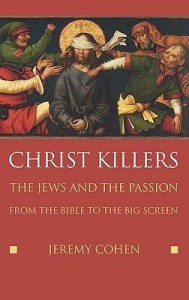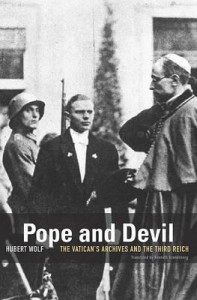ACCH Quarterly Vol. 17, No. 1, March 2011
Review of Jeremy Cohen, Christ Killers: The Jews and the Passion from the Bible to the Big Screen (New York: Oxford University Press, 2007), 313 pp. ISBN: 978-0-19-517841-8.
By Heath A. Spencer, Seattle University
 In this book, Cohen explores the origin and evolution of the Christ-killer myth from the first century to the present, focusing his analysis on religious texts, sculptures, paintings, stage plays, and films. The result is a fascinating but sobering study of an idea that has troubled Christian-Jewish relations and contributed to considerable anti-Jewish violence.
In this book, Cohen explores the origin and evolution of the Christ-killer myth from the first century to the present, focusing his analysis on religious texts, sculptures, paintings, stage plays, and films. The result is a fascinating but sobering study of an idea that has troubled Christian-Jewish relations and contributed to considerable anti-Jewish violence.
Cohen begins by noting that New Testament stories of Jesus’ crucifixion stood firmly within Jewish traditions, drawing inspiration from the Akedah, Passover, and “suffering servant” motifs as well as themes like deliverance and atonement that were already present in Jewish theology. Unfortunately, the passion narratives also assign Jewish leaders a key role in Jesus’ arrest and trial, and they depict a Jewish crowd that demands his death. In Matthew’s Gospel, the crowd even cries out, “His blood be on us and our children!” Cohen is aware that Christians do not all draw the same conclusions from these stories, and he introduces the reader to a range of views among contemporary New Testament scholars, from those who see the passion narratives as historically reliable to those who understand them as “prophecy historicized” (23) or “the Christian faith put in narrative form” (16). However, even if some of this scholarship has the potential to mitigate anti-Jewish readings of the New Testament, most Christians are not familiar with it and are more likely to be influenced by a long tradition of anti-Jewish thought that builds on and embellishes the already problematic content of the New Testament passion narratives.
Cohen continues with a survey of Christian theologians from antiquity to the early modern era who commented on the passion, noting that most of them promoted the idea – already present in Matthew’s Gospel – that all Jews were guilty of the crucifixion. Theologians from Augustine to Anselm argued that first-century Jews killed Jesus in ignorance, not realizing he was the Son of God. However, from the twelfth century on a more sinister view gained currency, as theologians like Peter Lombard, Thomas Aquinas, and John Duns Scotus imagined that Jewish leaders were willfully ignorant, killing Jesus out of hatred and envy. They would have known Jesus was divine, so the argument ran, if they had not been blinded by their malice. The notion that Jews were obstinate in their unbelief coincided with more hostile appraisals of Talmudic Judaism and dovetailed with accusations of ritual murder, ritual cannibalism, and host desecration that emerged in the twelfth century and continued into the modern era. Devotional manuals from this period also instructed readers to imagine Jesus’ suffering (along with those who inflicted it) at length and in exquisite detail. Together, these developments indicate an intensification of the Christ-killer myth and a tendency to see contemporary Jews as intentional Christ killers.
Cohen’s exploration of “The Myth and the Arts” reveals a fascinating correlation between developments in Christian theology and the visual arts. For example, early medieval depictions of the figures “Synagoga” and “Ecclesia” reflected the belief that Jews rejected Christ out of ignorance, whereas works from later periods depicted Jews (but not Romans) enthusiastically torturing Christ in his final hours. Often, the Jewish tormentors were shown wearing the same kinds of clothing as the artist’s contemporaries, collapsing past and present in a provocative manner.
The book ends with analysis of the Christ-killer myth on stage and on the screen. Cohen tracks the evolution of the famous Oberammergaupassion play, which had a strong anti-Jewish slant until quite recently but then went through considerable revisions in 1980, 1984, 1990, and 2000. The blood curse of Matthew’s Gospel has been eliminated, Pilate is portrayed less sympathetically, and Jesus’ Jewish identity is acknowledged. However, the Jewish priests still conspire against Jesus and the Jewish crowd still demands his death, so Cohen sees the changes as largely cosmetic. Films about the passion also get mixed reviews. Il Vangelo secondo Matteo (1964) portrays Jews as obstinate, but it also universalizes the story, making it suitable as a commentary on twentieth-century Italy. The Gospel of John (2003) does a better job than the Fourth Gospel itself in placing Jesus in his Jewish context, and it projects much of the evil onto a single Jewish antagonist. Nevertheless, Cohen still sees an anti-Jewish bias in the depiction of the Pharisees and the crowd. The Last Temptation of Christ (1988) and Jesus of Montreal (1989) largely avoid overt anti-Judaism, though the public controversy over Scorcese’s film brought some antisemitic rhetoric out into the open. Mel Gibson’s The Passion of the Christ (2004), on the other hand, exonerates Pilate, demonizes Jesus’ antagonists while highlighting their “Jewishness,” and serves as a stark reminder that the Christ-killer myth still resonates with many in spite of all the work that has gone into debunking it.
One serious weakness of Cohen’s book is its almost exclusive emphasis on intellectuals, artists, and other elite individuals. Several other recent studies on religion and violence demonstrate that the behavior of ordinary people did not always correspond to the decrees of rulers or the writings of intellectuals. Benjamin Kaplan’s Divided by Faith: Religious Conflict and the Practice of Toleration shows that in early modern Europe, hateful ideas were often combined with a kind of pragmatic toleration. New Testament scholar Amy-Jill Levine (The Misunderstood Jew: The Church and the Scandal of the Jewish Jesus) sees a similar phenomenon in contemporary American society. Cohen promises that his book will explore “the direct effect that theology had on the treatment of Jews in Christian lands” during the Middle Ages (6), but in most cases he simply assumes that bad theology will have uniformly bad effects, as if ideas had a consistent and autonomous power regardless of context. For example, Cohen presents the famous example of Thomas of Monmouth, who used a ritual murder accusation to promote the cult of St. William of Norwich. However, one might also want to know what impact such a story had in a given locale. Did it lead to popular violence, judicial murder, or apathy? How many people cared enough to visit the shrine? Anthony Bayle’s “Fictions of Judaism in England before 1290” (in Patricia Skinner, ed., Jews in Medieval Britain) reveals that donations to the shrine of St. William of Norwich eventually fell as low as 6d per year, an indication that ritual murder accusations did not always gain traction or maintain their appeal. Medievalists Robert Chazan (In the Year 1096…The First Crusade and the Jews) and Jonathan Elukin (Living Together, Living Apart: Rethinking Jewish-Christian Relations in the Middle Ages) also highlight the broad spectrum of Christian attitudes and behaviors toward Jews, even during episodes of intense conflict. Understanding the causes of anti-Jewish violence – or its absence – requires more than a mere survey of anti-Jewish ideas.
Cohen does acknowledge important shifts in Christian teaching following the Holocaust, most notably in the Catholic declaration Nostra Aetate. However, he finds such developments insufficient because they fail to challenge the historicity of the New Testament passion narratives and often refuse to acknowledge the contribution of the churches to a long history of anti-Jewish thought and action. If the source of the Christ-killer myth is the New Testament itself, Christians are faced with an intractable problem, and Cohen expresses little optimism they will achieve a satisfactory resolution. Nevertheless, his book can raise awareness among Christians that their scriptures and institutions have created an anti-Jewish mythology with destructive potential. Perhaps such awareness will deny the myth some of its power, even if it can’t be eradicated.


